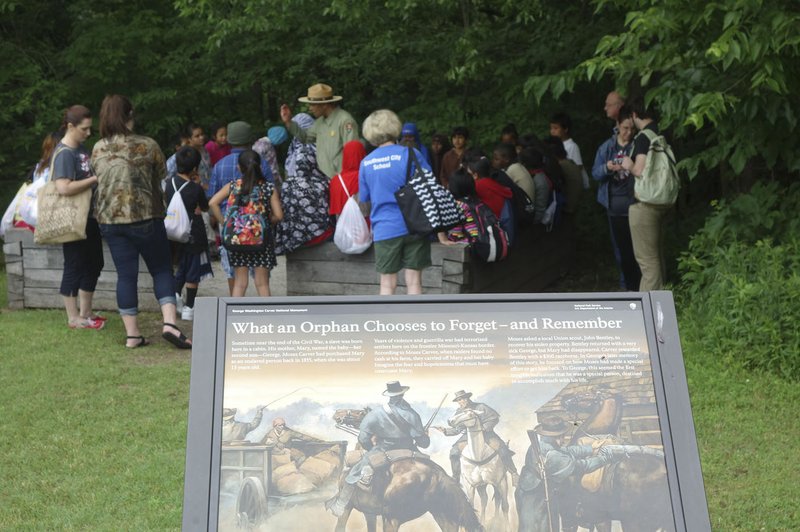The George Washington Carver National Monument in Diamond, Mo., is as unique as the man it memorializes. Born during the Civil War, Carver was the first African-American to attend Iowa Agricultural College -- now Iowa State University -- let alone earn bachelor's and master's degrees there. And he was the first to have a national monument dedicated to him, just a few months after his death on Jan. 5, 1943.
"Here the U.S. was in the middle of a world war, and [President Franklin D.] Roosevelt took time to create a national monument for Carver," Park Ranger Curtis Gregory says with wonder in his voice.
FAQ
Sandwiched In:
George Washington Carver
WHEN — Noon Feb. 21
WHERE — Shiloh Museum of Ozark History in Springdale
COST — Free
INFO — 750-8165
FYI
George Washington Carver
National Monument
WHAT — 240 acres including the Moses Carver farm
WHEN — 9 a.m.-5 p.m. daily
WHERE — 2 miles west of Diamond, Mo.
COST — Free
INFO — 417-325-4151
BONUS — The park will celebrate its 75th anniversary July 14.
This year, the George Washington Carver National Monument celebrates its 75th anniversary, and in addition to the slide show on Carver that Gregory will bring to the Shiloh Museum of Ozark History on Feb. 21, some 8,000 to 10,000 schoolchildren will visit the park in 2018.
"They ask the typical kid questions," Gregory says. "A lot of questions about peanuts. But sometimes they'll ask the deeper questions about the obstacles George faced or the prejudice George faced.
"Definitely what I try to do is tell young people there are obstacles that stand in everyone's way, but you can overcome them. George Washington Carver is a great example of that."
Carver was born around 1864 to Mary, a slave owned by Moses and Susan Carver. As the story goes, just a week after his birth, he, his sister and his mother were kidnapped by raiders from Arkansas and sold in Kentucky. Moses Carver sent men to recover all three, but only the baby was brought back to Missouri.
"We don't know much about his early years," Gregory says, "except that the Carvers took care of him and his brother James. I think he maybe had a happy childhood, but he didn't know a lot about the outside world."
Mrs. Carver taught George to read and write, and as a young man, he walked 8 miles to Neosho, Mo., to attend a school for black children. History says this is when he became known as George Carver, not "Carver's George," which had identified him as a possession.
"Think about the courage that took for a kid of 12," Gregory says. "He left here without anything, got to Neosho and found a couple that took him in. He struggled, but he always got help from good people."
Carver attended several schools before earning a high school diploma in Minneapolis, Kan., and being accepted to Highland College in Highland, Kan. -- until administrators found out he was African-American. Instead of attending classes, he homesteaded a claim there and then, in 1890, enrolled to study art and music at Simpson College in Iowa.
"Most people, when they think of George Washington Carver, think of the peanut," says Gregory, referring to Carver's work in Tuskegee, Ala. "But he was much more than that. He was an educator, he was a musician, he was an artist -- not many people know that -- and kind of a humanitarian as well."
After his graduation from Iowa Agricultural College, Carver was hired in 1896 to run the agriculture department at Tuskegee Institute, where he taught for 47 years. He is best known for devising more than 300 products from peanuts and 118 from sweet potatoes. And although his biography points out he did not invent peanut butter, he did suggest turning the cotton fields of the south into fields of soybeans and peanuts, studied and taught crop rotation, pioneered a mobile classroom to take lessons to farmers, wrote a syndicated newspaper column and spoke frequently about the possibilities for racial harmony in the United States.
Growing up in West Virginia, Gregory says, he learned the "same little bit about George Washington Carver that was in that chapter with Frederick Douglass and Harriet Tubman. But I always wanted to be a park ranger, and I wanted to work at a park dedicated to African-American history." He joined the staff in Diamond 14 years ago, telling not only the story of Carver's birth, but the story of his life.
NAN What's Up on 02/18/2018

